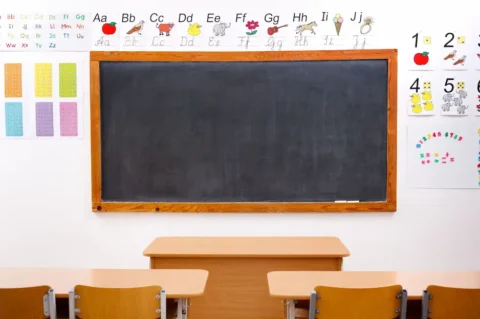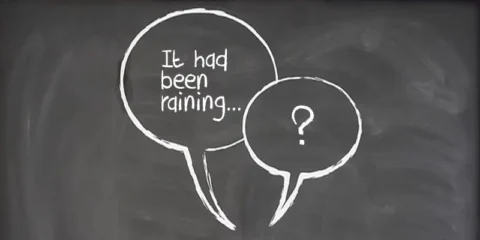Every teacher knows the feeling: you’ve explained a new structure, the class nods along, the gap-fill goes smoothly… and then nobody can actually use it in a sentence of their own. That’s the moment where the design of your practice activites really matters.
Language practice isn’t just about checking understanding, it’s about helping learners produce language confidently and meaningfully. The difference between “knowing” and “being able to use” English lies in what we ask students to do with it after we present it.
From gap-fills to production
There’s nothing wrong with the occasional gap-fill – they help learners focus on form in a controlled way. But if our lessons stop there, students never make the leap from recognition to production. They need chances to build full sentences, respond to ideas, and connect language to real meaning.
Think of it this way: a gap-fill checks if learners can spot the correct verb. A productive task asks them to use that verb in a context that makes sense to them. For example, instead of completing “I ___ breakfast at 7am.”, ask learners to write or say three true sentences about their morning routine and compare them with a partner. Now they’re producing language, not just selecting it.
Why production matters
We acquire language by using it. Learners need time to build accuracy and confidence before the grammar sticks. As Krashen (1982) pointed out, real progress happens when learners feel relaxed enough to take small risks and experiment with new language – what he called a low “affective filter.”
This is also where the familiar Presentation – Practice – Production (PPP) model earns its name. After the presentation stage and some controlled practice, learners need space for freer, meaningful use – the production stage. It’s here that the gap between knowing a rule and using it fluently starts to close.
We can think of this as three overlapping parts that help make “production” more than just a quick role-play at the end of a lesson:
- Understanding: Building awareness of form and meaning through controlled practice.
- Connecting: Linking the new structure to what learners already know so it feels part of a bigger picture.
- Extending: Recycling and reusing it later in fresh contexts, so it moves from short-term memory to active language.
Seen this way, good practice activity design strengthens the “production” phase of a lesson – whether you’re following a PPP model or not – ensuring it is truly communicative, not just a short performance before the end of the lesson.
Design principles that make practice work
When planning your own activities, or choosing them from a coursebook, a few practical checks help ensure they’ll lead to real language use:
- Is the language meaningful? Tasks should connect to students’ lives or opinions, even in a simple way.
- Is there a reason to listen or read? Every speaking or writing task needs a purpose – to find information, agree, rank, compare, guess…
- Will they reuse the target form? Look for opportunities to repeat the structure naturally throughout the task.
As Thornbury and Harmer have often noted in their work on communicative teaching, learners need to use new language to mean something to someone. That’s the moment where production cements learning.
Bridging controlled and freer practice
In a typical PPP lesson, the jump from controlled practice to freer production can feel like a cliff edge. One moment students are filling in blanks, the next they’re told to “use it in a role play.” The best controlled practice activities bridge that gap gradually, keeping enough structure to support accuracy while giving learners real choices about what to say.
For example, instead of a simple substitution drill (“I went to the cinema / I went to the park”), give students prompts that need a personal response: “What did you actually do last weekend?” or “What’s the best film you’ve seen recently?” They still use the same form, but now the answers are theirs. The shift from repetition to communication happens naturally.
Another easy bridge is the “half open” dialogue. Write the first half of each line on the board (“A: Have you ever…?” / “B: Yes, I have. I…”) and let students complete the rest in pairs. They get the safety net of a model, but they also have to create meaning, not just form.
These “in-between” stages help learners move from accuracy to fluency without losing confidence. They keep grammar in focus but make it feel alive – a small but crucial step in turning practice into communication.
Classroom ideas that make production real
You don’t need complicated new methods to get students producing language – just small tweaks that turn routine tasks into real communication. Here are a few ideas that go beyond the usual gap-fill or pair chat:
- Find someone who… (with a twist): Keep the mingling element, but change the aim. Instead of just collecting “yes/no” answers, students write one short follow-up note per person (“Ana’s been to Italy – she said the food was amazing but the trains were terrible”). It adds meaning, humour, and real listening.
- Memory chain stories: Each learner adds one sentence to a growing story using the target structure, but they must repeat the previous lines first. It’s fun, slightly chaotic, and forces meaningful repetition without it feeling mechanical.
- Role cards with consequences: Give pairs a mini dilemma (“Your flatmate always leaves dirty dishes – what do you say?”). After the conversation, have one person report to the class what actually happened next. The retelling stage naturally moves the tense or structure on (e.g., from present to past or past to reported speech).
- Image dominoes: Students match and connect pictures or short captions that tell a simple story, then describe the chain aloud. They have to justify each link (“We chose this next because she’s just finished cooking, and he’s about to eat”). It keeps grammar grounded in logic and narrative rather than form alone.
None of these ideas are revolutionary, but they shift the focus from accuracy drills to real use, memory, and connection. That’s where language starts to stick, and where practice starts to feel like communication.
Final thoughts
Good practice activity design doesn’t require fancy materials, just some thought about what we want students to do with the language. Move from recognition to production, from isolated form to meaningful use, and keep revisiting grammar in new contexts. The more chances learners have to speak and write with purpose, the more naturally English becomes part of their thinking, not just their memory.
It’s a simple shift, from “fill the gap” to “fill the silence”, but it makes all the difference.
Further reading
- Krashen, S. (1982). Principles and Practice in Second Language Acquisition.
- Thornbury, S. (1999). How to Teach Grammar.
- Harmer, J. (2007). The Practice of English Language Teaching.










8 comments
Cleedec
I agree. I work for a language school in Prague, Czech Republic and the school has already accepted the idea that the communicative teaching method should be used more, and it really is nowadays, than the old one based on grammatical filling gaps and translation, nevertheless, I think that you cannot teach without this as well. Both are needed and both serve their own purpose.
Anonymous
Hi, I agree with this article completely but what really interests me is the way we can relate content. You say the present perfect commonly fits with other structures such as superlative and past simple. Can you offer an article on this? I mean giving examples of the most common associated structures to provide meaningful learning? Thank you very much
Phil
Gap fills, how boring, in class I want to see the students faces not the tops of their heads as they do tasks that would put anyone to sleep. Gap fills are useful for homework, or board work. Gap fills with cut out pieces of paper and pair / group work is good to promote debate. On another subject. Elementary level students should not learn the present perfect!!! Your example of ‘What is the best restaurant you have ever been to?’ is too complex at this level. My EFL teaching career started in 1993 and continues to today. I have taught many upper intermediate students who confuse the past simple and present perfect using it with past time markers, ‘last year I have visited London’ would be typical. Why ? Because throughout their English learning experience the importance of the present perfect has been emphasised over and over again to the detriment of the past simple. The past simple is more useful to the lower level student. They must learn to sit up before they can run. I see my role is to give the students the confidence and opportunity to use the English they have been taught.
Jan-Joscha Finger
So good to hear someone else say it! Here in Spain, we live under the tyranny of cloze -with predictable results. Mind if I put the article (with source, no worries) on my own, rather less than well-known site, elt-one.webs.com ?
Anonymous
I think lessons need to be progressive. That is, that they need to start off with controlled practice and lead onto fluency practice. Gap fills are great as controlled, but then the students need to move onto more productive activities. Then, at the end, write up some of the mistakes and have the students correct them, to reinforce what they learned during the controlled practice. I think it’s ok to teach elementary students the present perfect; it’s a very useful tense to know. But of course the past simple should come first, then teach the present perfect as a contrast. If it’s taught well enough, students will gain a lot.
Ziya
Well, you have a good point and I mostly agree with your approach. However, it doesn’t seem so proper to leave out ‘gap fills’. It may be useful at the early stage of learning if combined with other related activities.
Most of us know that there are different approaches, methods, factors and expectations in language teaching and learning. Though they may differ from each other to an extent, basically they all have the same goal; that is to have learners communicate in the target language. Therefore, while teaching we need all of them more or less. As long as we adjust the doses according to learners’ needs and expectations, we can make use of all different tools to help learners.
I personally believe that writing and speaking activities are crucial in production of the language if done under the guidance of the teacher. Having learners write something or discuss something is not enough, teachers need to observe them carefully and correct them properly and make them understand from their mistakes.
As for grammar, though grammar and I are not good friends, we still need each other’. Maybe this expression may seem a bit ‘too strong’ but I tend to say ”grammar is the skeleton of a language and without it, a language can not move.’ The point is how we teach grammar, whether we make it more boring or exciting. I do believe ‘grammar in context’ and activities must combine different grammar points in a single piece of writing so that learners can see and comprehend the differences and similarities.
We need to consider various factors that greatly influence the learners’ language learning and acquisition such as their sociolinguistic and psycholinguistic background, what kind of learners they are, their needs, their personal differences in SLA like age, gender, motivation, working memory, context etc. so that we’ll be able to choose and use suitable ways and materials.
Heather
I disagree with the responses here. This article does not discuss gap fills as a production activity. Clearly it is not. It is, however, one way for students to come to an understanding of a certain grammatical point. There is nothing wrong with reinforcement through repetition…this allows a learner to internalize the concept in order for it to be used in production activities. It seems to me that this is not so much a problem with gap fills, as it is with considering gap fills to be a type of production activity.
Gary
I see “gap-fill’ or ‘closure’ activities as receptive tasks NOT productive writing tasks. Similar to multiple choice questions, it’s all about reading and selecting ‘one’ answer to complete the collocation. Productive tasks, as mentioned in the article require ‘making’ words fit or collocate through recycling grammar/language structures, vocabulary and tense. It’s not about whether ‘gap-fill’ is good or not but when in the instructional process, in this case productive writing, it should or shouldn’t be used.